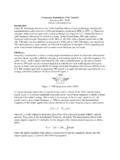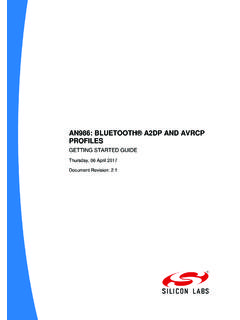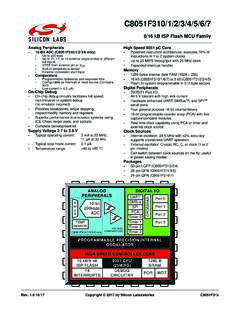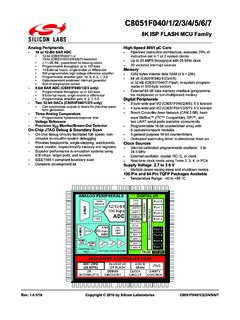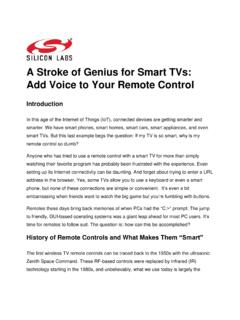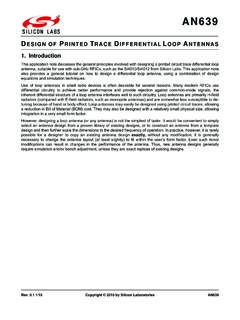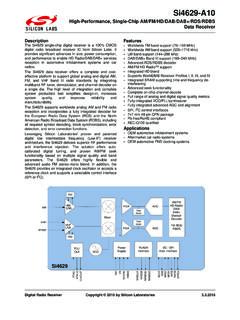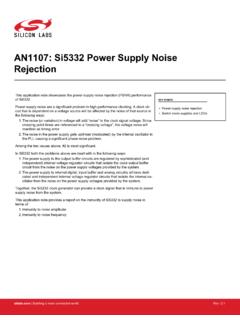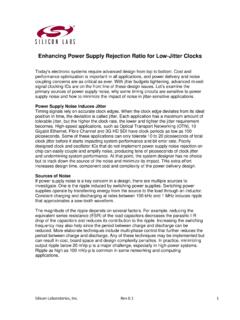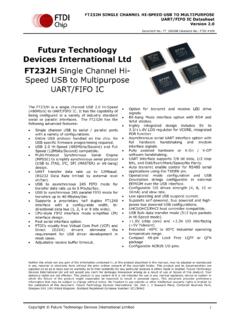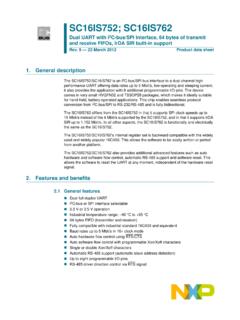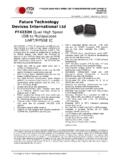Transcription of AN0059.0: UART Flow Control - Silicon Labs
1 : uart Flow Control This application note describes how to implement hardware or software flow Control for uart . KEY POINTS. This application note includes the following: uart Flow Control is a strategy for the communication bewteen slow and fast This PDF document devices without data losing. Source files (zip) Introduce the protocols of hardware flow Example C-code Control , legacy hardware flow Control , and Multiple IDE projects software flow Control . uart hardware flow Control is fully supported by UARTDRV, and uart . software flow Control is partially supported by the driver.
2 Device A Device B. TX TX. RX RX. CTS CTS. RTS RTS. GND GND. | Building a more connected world. Rev. : uart Flow Control Device Compatibility 1. Device Compatibility This application note supports multiple device families, and some functionality is different depending on the device. EFM32 MCU series 0 consists of: EFM32 Gecko (EFM32G). EFM32 Tiny Gecko (EFM32TG). EFM32 Giant Gecko (EFM32GG). EFM32 Leopard Gecko (EFM32LG). EFM32 Wonder Gecko (EFM32WG). EFM32 Zero Gecko (EFM32ZG). EFM32 Happy Gecko (EFM32HG). EZR32 Wireless MCU series 0 consists of: EZR32 Leopard Gecko (EZR32LG).
3 EZR32 Wonder Gecko (EZR32WG). EZR32 Happy Gecko (EZR32HG). | Building a more connected world. Rev. | 2. : uart Flow Control uart Flow Control Introduction 2. uart Flow Control Introduction uart Flow Control is a method for slow and fast devices to communicate with each other over uart without the risk of losing data. Consider the case where two units are communicating over uart . A transmitter T is sending a long stream of bytes to a receiver R. R. is a slower device than T, and at some point R cannot keep up. It needs to either do some processing on the data or empty some buffers before it can keep receiving data.
4 R needs to tell T to stop transmitting for a while. This is where flow Control comes in. Flow Control provides extra signaling to inform the transmitter that it should stop (pause) or start (resume) the transmission. Several forms of flow Control exist. For example, hardware flow Control uses extra wires, where the logic level on these wires define whether the transmitter should keep sending data or stop. With software flow Control , special characters are sent over the normal data lines to start or stop the transmission. | Building a more connected world.
5 Rev. | 3. : uart Flow Control Flow Control Protocols 3. Flow Control Protocols This chapter describes the three most common ways to implement flow Control . Hardware Flow Control With hardware flow Control (also called RTS/CTS flow Control ), two extra wires are needed in addition to the data lines. They are called RTS (Request to Send) and CTS (Clear to Send). These wires are cross-coupled between the two devices, so RTS on one device is connected to CTS on the remote device and vice versa. Each device will use its RTS to output if it is ready to accept new data and read CTS to see if it is allowed to send data to the other device.
6 As long as a device is ready to accept more data, it will keep the RTS line asserted. It will deassert RTS some time before its receive buffer is full. There might still be data on the line and in the other device transmit registers which has to be received even after RTS has been deasserted. The other device is required to respect the flow Control signal and pause the transmission until RTS is again asserted. Device A Device B. TX TX. RX RX. CTS CTS. RTS RTS. GND GND. Figure Hardware Flow Control The flow Control is bidirectional, meaning both devices can request a halt in transmission.
7 If one of the devices never has to request a stop in transmission ( it is fast enough to always receive data), the CTS signal on the other device can be tied to the asserted logic level. The RTS pin on the fast device can thus be freed up to other functions. Legacy Hardware Flow Control A point of confusion when talking about hardware flow Control is that the same names are used for different protocols. Hardware Flow Control sometimes refer to another method for flow Control . In this document we shall refer to this second method as legacy Hardware Flow Control to differentiate it from the type discussed in Hardware Flow Control .
8 The name legacy is used because this method was actually the early method of implementing flow Control . DTE DCE. TX TX. RX RX. CTS CTS. RTS RTS. GND GND. Figure Legacy Hardware Flow Control Legacy Hardware Flow Control still uses two extra wires named RTS and CTS, but the functionality is slightly different. In this scheme the flow Control is unidirectional and there is a master/slave relationship (traditionally the master and slave are referred to as DTE (Data Terminal Equipment) and DCE (Data Communications Equipment)). When the master wants to transmit data to the slave it asserts the RTS line.
9 The slave responds by asserting CTS. Transmission can then occur until the slave deasserts CTS, indicating that it needs a temporary halt in transmission. When the master has finished transmitting the entire message it will deassert RTS. | Building a more connected world. Rev. | 4. : uart Flow Control Flow Control Protocols Software Flow Control Software flow Control does not use extra wires. Only 3 wires are required (RX, TX, and GND). Transmission is started and stopped by sending special flow Control characters. The flow Control characters are sent over the normal TX and RX lines.
10 The flow Control charac- ters are typically the ASCII codes XON and XOFF (0x11 and 0x13). If device A sends XOFF to device B it means that B should halt transmission to A until B receives an XON character from A. | Building a more connected world. Rev. | 5. : uart Flow Control Software Examples 4. Software Examples There are two kinds of examples provided regarding uart flow Control . Examples with emlib and examples with emdrv (uartdrv). For each kind of example, users can select the demo for Hardware flow Control , Software flow Control using the PB1 button on the STK.
